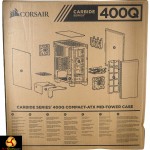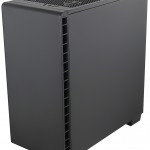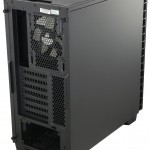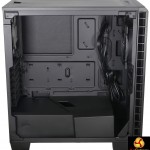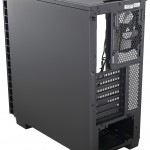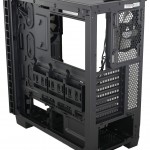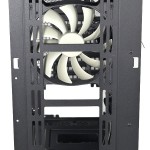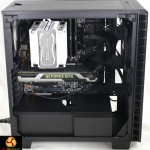
Corsair Carbide 400Q is the junior sibling of the Carbide 600C we saw quite recently. The Q suffix stands for Quiet and C for Clear (i.e. it has a windowed panel) and both Carbide 400 and 600 come in Q and C variants. Unboxing the 400Q reveals a case that looks understated. It lacks the visual wow factor of the enormous window we saw in the 600C and would presumably get with the 400C. It makes life easier if we put Carbide 600 to one side as that design uses an unconventional upside-down layout and is also very wide. By contrast the Carbide 400 is a slimline ATX tower that is only 215mm wide. Pulling off the side panels reveals the noise deadening material that has been added to qualify for the Quiet name tag and it should be a quick job to remove the power supply cover and front panel and lay the case bare.
Specification:
- Motherboard support: ATX, Micro-ATX, Mini-ITX.
- Expansion slots: 7.
- Included fans: 1x 140mm AF140L front intake, 1x 120mm AF120L rear exhaust.
- Fan mounts: 2x 120mm/140mm roof, 3x 120mm or 2x 140mm front.
- 120mm radiator mounts: 120mm/240mm/360mm front, 120mm rear.
- 140mm radiator mounts: 140mm/280mm front.
- 5.25″ drive bays: None.
- Internal drive bays: 2x 2.5”/3.5”, 3×2.5″.
- Dimensions: 463mm H x 425mm D x 215mm W.
As you can see in our photos the power supply cover is a significant feature of the Carbide 400. It uses a split design with each part retained by a thumb screw on the rear of the case. The front section covers the two 3.5-inch drive bays and the rear section covers the power supply. These covers look perfectly OK at a short distance but when you get up close you can see they are fairly lightweight plastic.
The front panel is also significant as it covers the full length dust filter at the front of the case, however we found the retaining latches required a degree of force to release the panel. If you fancy installing a radiator at the front of the case you will need to remove the panel to get the access you require, and will very likely have to remove the AF140L fan that comes as part of the package.
The two drive bays at the bottom of the case can be moved forward by 20mm to give you more space for the power supply, or you can remove the drive tower completely, however we consider this to be a bad move. The problem is that there are three 2.5-inch drop and lock bays on the rear of the motherboard tray and these get in the way of the cable management. The Carbide 400 is so slender that you either have space for the cables or for the drive bays, but cannot run the cables across the drive bays. Routing the cables around the bays is possible but a bit fiddly. It makes more sense to remove the three 2.5-inch bays and instead rely on the two bays at the bottom of the case.
In other respects the cable management is fairly good. There are plenty of cable tie anchor points and three large grommetted cable management holes. We did, however, cause ourselves a problem by trying to feed the audio cable through a likely looking hole which is actually required to locate the power supply cover.
It didn't make a lot of sense to remove the stock 140mm fan at the front of the case and with that in mind we opted for a Phanteks 120mm air cooler in our test system, instead of an All In One liquid cooler.
Testing
To put this case through its cooling paces we will be using a test system consisting of an Intel Core i7-6700K, GTX 980 and an SSD.
This system allows us to produce a substantial amount of heat and effectively test the Corsair Carbide 400Q‘s cooling capabilities.
For stress testing we use AIDA64 to create the maximum heat output to stress our CPU and GPU.
Test System:
- Processor: 4.2GHz Intel Core i7-6700K
- Motherboard: Gigabyte Z170XP-SLI
- CPU cooler: Phanteks PH-TC12DX
- Memory: Corsair Vengeance LPX DDR4-3200MHz RAM
- Graphics card: GTX 980 4GB
- Power supply: Seasonic Platinum Fanless 520W
- Storage drives: SanDisk Extreme SSD
- OS: Windows 10 64-bit.
Cooling Performance
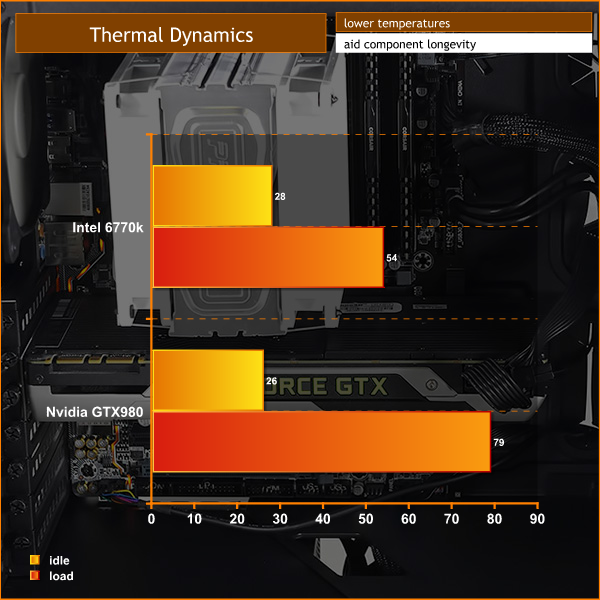
Cooling in a quiet case can be problematic however the Carbide 400Q did a good job. The Skylake Core i7-6700K ran below 60 degrees at all times despite the 100 percent load applied by AIDA 64.
The Phanteks PH-TX12DX cooler we used is a decent piece of hardware but you can be confident that a liquid cooler would lower temperatures even further. Our GTX 980 graphics card ran just below 80 degrees, which is exactly what we expected to see.
Acoustics Performance
The combination of slender form factor and thin noise deadening material didn't fill us with confidence so we are pleased to report that at idle the Carbide 400Q is effectively silent. When the CPU starts to work hard the fans are clearly audible but this is more a change in pitch, rather than an increase in volume.
We were impressed by Carbide 400Q although it has to be said that there are a number of other cases on the market that do an equally good job.
Closing Thoughts
Corsair has got most of the big parts of Carbide 400Q bang on the money. We like the slink form factor and pair of factory fitted fans, and the stealth drive bays in the floor of the case are good to see. We have no problem with the absence of an optical drive bay although we know many KitGuru readers require an optical drive and see a problem when there is no 5.25-inch bay.
The headline features are the split power supply cover and the dust filter at the front of the case. Both of these features work well enough but a simple one-piece power supply cover works just as well. We hope that you find it easy to unlatch the front panel to clean the dust filter as we struggled with this aspect of the case.
Cosmetically the PC build looks quite tidy although cable routing in the region of the three 2.5-inch drive bays is clearly problematic. Remove these drive bays and the rear of the case looks much neater. We like the way Corsair has included a good number of cable tie anchor points and feel that a few more in the centre of the case would help matters.
Discuss on our Facebook page, over HERE.
Pros:
- Very quiet operation.
- Tidy styling
- Dust filters at the bottom and front.
- Plenty of space to add a liquid cooler up to 360mm at the front of the case.
- AF140L fan at the front, AF120L fan at the rear.
Cons:
- Cable management is awkward around the 2.5-inch drive bays.
- Front panel has to be unlatched to gain access to the front air filter.
- There isn't enough room in the roof of the case to install a radiator unless you have a particularly small motherboard.
- Price is fairly high.
- Some KitGuru enthusiasts will be unhappy there is no optical drive bay.
KitGuru says: The Corsair Carbide 400Q is a solid chassis but it faces some stiff competition at the price.
 KitGuru KitGuru.net – Tech News | Hardware News | Hardware Reviews | IOS | Mobile | Gaming | Graphics Cards
KitGuru KitGuru.net – Tech News | Hardware News | Hardware Reviews | IOS | Mobile | Gaming | Graphics Cards



